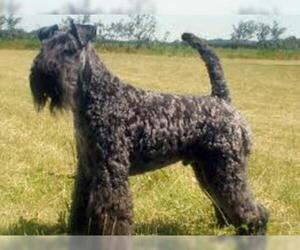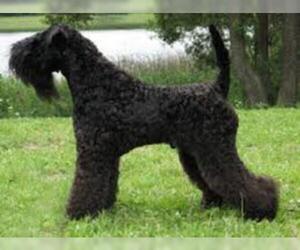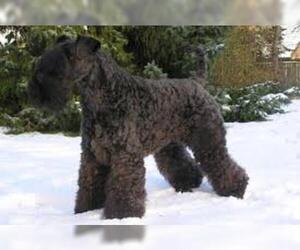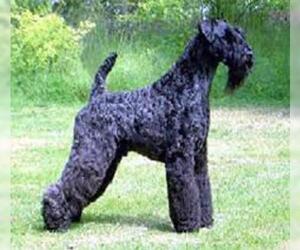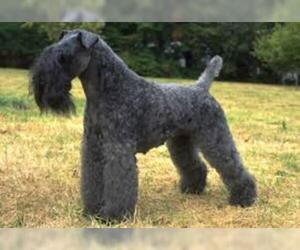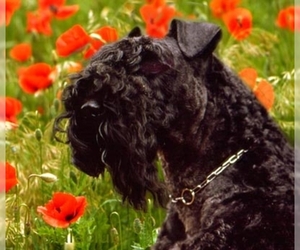
All about Kerry Blue Terrier dog breed
A.K.A. :Irish Blue, Blue Terrier, Kerries, Kerry, Irish Blue Terrier
Size
Grooming requirements
Exercise requirements
Good with other dogs
Watchdog ability
Energetic
Training requirements
Playful
Affectionate
Good with other pets
Good with children
Good with strangers
Winter
Summer
Healthiness
Protective
Life Span
| Pure Breeds | Member |
| Breeds A - Z | K |
| Breeds by Group | Terrier |
| Breeds by Trait | Hypoallergenic Low Shedding |
| Overview: | The Kerry Blue Terrier, a striking breed originating from County Kerry, Ireland, is renowned for its beautiful, soft, wavy blue coat that ranges from deep slate to light blue-grey. Initially bred as an all-around farm dog, adept at hunting vermin and herding livestock, they are medium-sized, muscular dogs with a distinctive squared-off head and a confident stance. Temperamentally, Kerries are intelligent, spirited, and loyal companions, often possessing a strong prey drive and an independent streak that requires consistent training and socialization from a young age. While affectionate with their families, their energetic nature means they thrive with active owners who can provide ample exercise and mental stimulation. They can be suitable for families with older, respectful children, but their assertive personality might not be ideal for first-time dog owners or those seeking a docile lapdog. With proper training, they can adapt to apartment living if their exercise needs are met. Health-wise, they are generally robust but can be prone to certain conditions like hip dysplasia, cataracts, and various skin sensitivities. |
F.A.Q.
All You Need to Know About the Kerry Blue Terrier BreedThe Kerry Blue Terrier, originating from Ireland’s County Kerry, is a striking breed known for its beautiful blue-gray coat and spirited personality. These medium-sized dogs are intelligent, loyal, and possess a playful yet protective nature, making them excellent family companions for those who can provide consistent training and socialization. While adaptable, their moderate exercise needs mean they thrive with daily walks and playtime; apartment living is possible with sufficient outdoor activity. Their signature soft, wavy, non-shedding coat requires regular grooming – typically professional clipping every 6-8 weeks – to prevent matting. Generally healthy, Kerry Blue Terriers can be prone to certain conditions like hip dysplasia and specific eye issues, so choosing a reputable breeder is crucial. Their energetic and inquisitive temperament makes them best suited for active families willing to engage them mentally and physically.
What is the average weight of a Kerry Blue Terrier?The average Kerry Blue Terrier weight for a healthy adult is between 33-40 pounds. Males typically weigh 33-40 pounds, while females range from 33-40 pounds. This provides a good indication of the breed's average size and a healthy weight for Kerry Blue Terrier adults.
Wondering, "how tall is a Kerry Blue Terrier?" You've come to the right place for details on their average size!
The Kerry Blue Terrier height typically ranges from 17.5 to 19.5 inches at the shoulder for adults. This is a robust, medium-sized breed known for its distinctive blue coat and confident stance.Typical Adult Kerry Blue Terrier Height Range (at the shoulder):
- Males: Generally stand between 18 to 19.5 inches.
- Females: Usually a bit smaller, ranging from 17.5 to 19 inches.
The Kerry Blue Terrier is exclusively recognized in various shades of blue. While puppies are born black, their coats progressively lighten to blue through a process called "clearing." AKC recognized Kerry Blue Terrier colors include:* Blue: This encompasses a wide spectrum, from a deep slate blue to a light smoky blue. All mature Kerry Blues are expected to be some shade of blue.There are no other officially recognized Kerry Blue Terrier colors by major kennel clubs like the AKC. Therefore, you will not find brindle, fawn, cream, white, lilac, merle, or chocolate Kerry Blue Terriers. If you encounter a Kerry Blue Terrier advertised with rare coat types or exotic Kerry Blue Terrier variations such as these, it is not considered purebred or within the breed standard. Reputable breeders focus solely on producing Kerry Blues with the correct blue coat.
The Kerry Blue Terrier possesses a distinctive and spirited Kerry Blue Terrier personality, known for its courage, intelligence, and a delightful sense of humor. This breed is friendly and deeply loyal to its family, often forming strong bonds. While generally sociable with people, they have a confident and sometimes assertive nature. They are quite adaptable to apartment living provided they receive sufficient exercise and mental stimulation, as they are intelligent and need to be kept busy.Regarding behavior with children, Kerry Blues can be wonderful companions, especially if raised with them from a young age and taught appropriate interactions. Their playful and affectionate side makes them good family dogs. However, their strong prey drive and terrier tenacity mean supervision is always recommended, particularly with very young children.When it comes to other pets, their temperament of Kerry Blue Terrier can be complex. They have a strong terrier instinct and can be dominant with other dogs, particularly those of the same sex. Early socialization is crucial for them to learn appropriate behavior with other canines. Their high prey drive also means they may not be suitable for homes with smaller, non-canine pets unless introduced and managed carefully from a young age. Overall, the Kerry Blue Terrier is a spirited, devoted, and engaging companion for an owner who appreciates their unique blend of charm, courage, and intelligence.
The Kerry Blue Terrier temperament is a captivating blend of confidence, charm, and spirited terrier tenacity. Known for their loyalty and affectionate nature with their families, they are often described as having a "big dog" personality in a medium-sized package. They are generally friendly and sociable with people they know, often greeting visitors with a curious but reserved demeanor initially. Kerries are highly intelligent and devoted companion dogs, thriving on interaction and inclusion in family activities.
While adaptable to apartment living, especially with sufficient exercise and mental stimulation, they benefit from a secure yard for their playful antics. They are generally good with children, particularly those they are raised with, though supervision is always recommended with any breed to ensure respectful interactions. Early socialization is crucial for positive behavior with other pets; they can live harmoniously with cats and other dogs if introduced properly from a young age, but their terrier prey drive may surface with smaller, unfamiliar animals. Kerries do have a tendency toward stubbornness and require consistent, positive reinforcement training. They are also sensitive to harsh correction and respond best to patient, firm, and fair handling. Their strong-willed yet loving disposition makes them a rewarding, engaging, and spirited companion for the right owner.Kerry Blue Terrier care involves several key aspects for a happy, healthy companion. This breed requires regular grooming to maintain its unique coat. Aim for weekly brushing to prevent matting and professional grooming every 6-8 weeks for a proper trim. Unlike some brachycephalic breeds, the Kerry Blue Terrier is not brachycephalic; therefore, it doesn't have the associated climate sensitivity or wrinkle cleaning needs. Their ears do need regular checks and cleaning to prevent infections.
For exercise limitations, Kerry Blues are active and intelligent. They need daily exercise, such as walks, playtime, and mental stimulation, to prevent boredom and destructive behaviors. They are not a "low-energy dog breed." Dietary considerations include a high-quality, balanced diet appropriate for their age and activity level. Weight management is crucial to prevent strain on joints and other health issues; avoid overfeeding and excessive treats. Regarding health tips for Kerry Blue Terrier, common concerns include skin issues (allergies are not uncommon) and luxating patella. Regular dental care, including brushing and professional cleanings, is essential to prevent periodontal disease. Routine vet check-ups are vital for early detection and prevention of potential health problems. This guide covers "how to care for a Kerry Blue Terrier" and ensures "daily maintenance" is understood for this robust and charming breed.Kerry Blue Terrier Activity Level: How active are Kerry Blue Terriers? Kerry Blue Terriers possess a moderate to high activity level, balancing bursts of energetic playtime with periods of calm rest. They are not hyperactive but require consistent daily exercise to maintain their physical and mental well-being. Their exercise needs typically include a brisk 30-60 minute walk daily, supplemented with engaging playtime in a secure yard. They love to chase, retrieve, and engage in active games, making them suitable for families who enjoy outdoor activities. While they enjoy active playtime, it's crucial to be mindful of their brachycephalic (short-nosed) anatomy. This means they are prone to overheating, especially in warm weather or during strenuous exercise. Limit intense activity during hot parts of the day and ensure they always have access to water and shade. Kerry Blue Terriers thrive on human interaction during their activity, preferring to play with their family rather than being left to their own devices. They are adaptable and can fit well into both active families who enjoy regular walks and games, as well as slightly less active households willing to commit to their daily exercise requirements. They are not ideal for extremely low-energy households that cannot provide adequate stimulation. Regular mental stimulation, through training and puzzle toys, is also important to prevent boredom and destructive behaviors. Understanding their exercise needs is key to a happy and healthy Kerry Blue Terrier.
Kerry Blue Terrier health problems include several inherited and structural concerns that may affect long-term wellness. Among the common Kerry Blue Terrier medical issues are hip dysplasia, which can lead to joint pain and reduced mobility, especially in aging or overweight dogs. Degenerative myelopathy is a serious spinal condition documented in the breed, causing progressive loss of coordination and mobility. Allergies—particularly environmental and food-related—are frequent, often resulting in skin irritation, ear infections, and chronic scratching. Their dense, curly coat may trap moisture, increasing the risk of skin fold infections and hot spots if not properly groomed and dried.
Kerry Blue Terriers are not brachycephalic, so brachycephalic dog care practices are generally unnecessary. However, their thick coat and active nature make them susceptible to heat sensitivity, especially during warm weather or vigorous exercise. Providing shade, hydration, and rest breaks is essential. Spinal problems may also develop with age or poor conditioning, particularly in dogs with a history of jumping or rough play.
Understanding how to keep Kerry Blue Terrier healthy involves regular veterinary checkups, early screening for orthopedic and neurological conditions, consistent grooming to manage their coat, weight control, and tailored exercise routines. With attentive care, Kerry Blue Terriers can enjoy a spirited, affectionate life of 12–15 years.
Breed Breakdown: What Experts Say About the Kerry Blue Terrier
I would rate the "Size" trait of the Kerry Blue Terrier as a 6.The Kerry Blue Terrier is a medium-sized dog, generally falling into the larger end of that category. Males typically stand around 18-19.5 inches tall and weigh 33-40 pounds, with females being slightly smaller. Their body structure is robust and well-muscled, giving them a substantial presence without being overly bulky.Compared to other companion dogs, they are noticeably larger than breeds like the Jack Russell Terrier or Shih Tzu, but significantly smaller than Great Danes or Mastiffs. They are a good "middle ground" in terms of size. While they can adapt to apartment living if they receive sufficient daily exercise, their energy levels and need for mental stimulation mean a larger living space, or at least regular access to an outdoor area, is preferable. Their moderate size makes them generally suitable for travel, as they can fit comfortably in most vehicles and are not too cumbersome to manage. However, their size and energy would likely be a consideration for households with extreme space constraints. They are not a "tiny" dog that can easily disappear into a small corner, but they are also not a "giant" dog that dominates a room.
I would rate the Kerry Blue Terrier's "Grooming Requirements" at a 7.This breed, while charming, is not for the faint of heart when it comes to grooming. Their dense, soft, wavy, and non-shedding (or very low-shedding) coat is a double-edged sword. While the lack of shedding is a plus for allergy sufferers and cleanliness, it means the coat grows continuously and is highly prone to matting. Regular, almost daily, brushing is essential to prevent tangles and knots from becoming unmanageable. Beyond brushing, the Kerry Blue Terrier requires professional grooming or significant owner dedication every 4-6 weeks for clipping and shaping to maintain its characteristic appearance and prevent the coat from becoming too long and cumbersome. Their ears also need regular cleaning, and nails, like most breeds, require frequent trimming. While they don't typically have excessive skin folds, their dense coat can hide skin issues if not properly maintained, and some individuals can be prone to skin allergies that require specific bathing and care. Compared to many companion dogs that might just need a weekly brush and occasional bath, the Kerry Blue Terrier definitely requires frequent, specialized grooming to keep them looking and feeling their best.
I would rate the Kerry Blue Terrier's "Exercise Requirements" at a 7.The Kerry Blue Terrier is a robust, energetic breed that definitely leans towards the higher end of the exercise spectrum. They aren't content with just a leisurely stroll around the block; they need structured activity and opportunities to expend their considerable energy. Daily long walks, vigorous playtime in a secure yard, or participation in dog sports like agility, obedience, or even earthdog trials are excellent ways to meet their physical and mental stimulation needs. Their terrier heritage means they have a natural drive and stamina, and they thrive on having a "job" to do, even if that job is just a long, engaging walk with their human. While not brachycephalic, meaning they don't typically suffer from respiratory limitations, their deep chest and muscular build are indicative of a dog bred for endurance and activity. They are generally not suitable for owners seeking a low-maintenance, sedentary companion; they truly require consistent, moderate-to-high levels of activity to remain healthy, well-behaved, and mentally content, otherwise, they can become bored and destructive.
I would rate the Kerry Blue Terrier's "Watchdog Ability" as a 7 out of 10.Kerry Blues are known for their intelligence, alertness, and strong territorial instincts. They are typically quick to notice anything out of the ordinary, whether it's an unfamiliar sound or a person approaching their home. Their barking behavior can be quite effective; while not prone to incessant nuisance barking, they will certainly vocalize loudly and persistently to alert their owners to potential threats. This isn't a breed that will passively observe an intruder. Their inherent confidence and protective nature, combined with their striking appearance, can be a deterrent. They are capable of providing meaningful early warnings and, if necessary, will position themselves between their family and what they perceive as a threat, making them more than just a passive companion. However, they generally lack the sheer intimidating size and historical purpose of breeds specifically bred for guarding, which is why they don't quite reach a 9 or 10. They are excellent at alerting and deterring through their presence and noise, but less likely to engage in physical confrontation than a dedicated protection breed.
Rating: 4Explanation: The Kerry Blue Terrier, while loyal and affectionate with its human family, generally scores low on the "Good with Other Dogs" scale. Their strong prey drive and inherent terrier feistiness often translate into a lack of tolerance for unfamiliar dogs. They can be particularly challenging with dogs of the same sex, displaying dominance and a readiness to challenge. While some well-socialized Kerry Blues may coexist peacefully in a multi-dog household, this usually requires careful, early introductions, consistent training, and often a significant amount of management. They are not a breed that typically thrives in random canine company and can be quick to escalate if they feel challenged or their space is invaded. Owners should anticipate the need for careful introductions, supervised interactions, and potentially a lifetime of management to ensure peaceful coexistence with other dogs, rather than expecting a naturally sociable companion.
I would rate the Kerry Blue Terrier's "Energetic" trait as a 7 out of 10.Kerry Blue Terriers are definitely active and spirited dogs, not at all laid-back in the way a Basset Hound might be. They possess a good deal of stamina and a strong desire for play, often enjoying vigorous games of fetch or chasing. Their working terrier heritage means they have a natural drive and an impressive ability to keep going, making them well-suited for various outdoor and athletic activities like agility, earthdog trials, or long hikes. They require consistent physical and mental stimulation to prevent boredom and destructive behaviors, indicating a higher energy level than many companion breeds.However, while energetic, they aren't quite the perpetual motion machines you might find in some herding breeds or working lines of terriers. They are generally able to settle down indoors after their exercise needs are met. It's also important to note that their brachycephalic anatomy, while not as pronounced as in some other breeds, can slightly affect their stamina and exercise tolerance, especially in hot weather or during intense, prolonged exertion. While they love to run and play, owners should be mindful of overheating and give them breaks, which can slightly temper their absolute highest potential for sustained, extreme activity compared to a dolichocephalic breed with similar energy levels. They can certainly participate in demanding activities, but careful management of their breathing is always a consideration.
I'd rate the Kerry Blue Terrier's "Training Requirements" a 7 out of 10.While highly intelligent and eager to please in the right hands, Kerry Blues are also known for their spirited independence and a streak of stubbornness that can make training challenging for the uninitiated. Their intelligence means they learn quickly, but it also means they can learn undesirable behaviors just as fast if not consistently guided. They have a good attention span for engaging tasks but can become bored or distracted if training is repetitive or lacks excitement. Responsiveness to commands can vary; they are generally responsive when they respect their handler, but they will test boundaries and try to exert their will if they sense an opening. Consistency is absolutely paramount; any lapse in rules or commands will be noted and exploited. Positive reinforcement is highly effective, as they thrive on praise and rewards, but harsh methods will quickly lead to resentment and a shutdown. This breed is generally not beginner-friendly and definitely requires experienced handling and a very structured, consistent routine from a young age to channel their energy and intelligence positively. Without it, they can become unruly and headstrong.
I would rate the Kerry Blue Terrier's "Playful" trait an 8 out of 10.Kerry Blues are naturally spirited and possess a zest for life that makes them wonderfully entertaining companions. They aren't as relentlessly hyper as some terriers, but they are far from laid-back. Their typical activity level is moderate to high, and they thrive on interaction and engagement. They absolutely love games, especially those involving chasing and retrieving, and will often initiate playtime with their humans. Their attention-seeking behavior during these moments is usually expressed through playful nudges, barks, or bringing a toy. They respond with great enthusiasm to toys and playtime, often engaging with a characteristic terrier bounce and wiggle. This breed generally maintains a joyful and enthusiastic demeanor in daily life, always ready for an adventure or a good romp, making them a consistently fun and engaging presence in the home.
I'd rate the Kerry Blue Terrier's "Affectionate" trait at a 7.While not typically described as an "in-your-face" cuddler like some other companion breeds, the Kerry Blue forms incredibly strong, devoted bonds with its family. They display their affection through fierce loyalty and a desire to be near their loved ones, often following family members from room to room. They are sensitive to owner emotions, quick to offer a comforting presence, and thrive on consistent human companionship. While they might not be the quintessential lap dog, they certainly enjoy physical closeness and will readily accept petting and attention. Their independence is more in their confident, spirited nature rather than a lack of desire for connection; they are definitely people-oriented dogs who flourish when integrated into the heart of their family.
Rating: 5Explanation: The Kerry Blue Terrier's "Good with Other Pets" trait falls squarely in the middle, earning a 5. This breed possesses a strong terrier prey drive, which means smaller, fast-moving animals like cats can be a significant challenge to integrate peacefully, often requiring extensive, early socialization and constant supervision. While many Kerry Blues can coexist with other dogs, especially when introduced as puppies, they can also exhibit same-sex aggression, particularly intact males, and may resource guard. Their independent and sometimes dominant nature means that successful multi-pet households typically require a highly experienced owner who understands the breed's instincts, commits to consistent training, and implements clear boundaries. They are not naturally sociable with other animals in the way a Labrador might be; instead, their peaceful coexistence is largely a product of diligent training, management, and careful selection of individual temperaments.
The Kerry Blue Terrier rates a 6 out of 10 for "Good with Children."While generally playful and affectionate with their own families, including children they've grown up with, their terrier heritage means they possess a strong prey drive and can be boisterous. They are intelligent and active, enjoying games and playtime, but their exuberance might be overwhelming for very young children. They can be tolerant of noise and handling from older, respectful children who understand how to interact with a dog, but may not have the inherent patience for the unpredictable actions of toddlers. Early socialization and consistent training are crucial to ensure they develop into well-mannered family members. Without proper guidance, their natural assertiveness can lead to them testing boundaries, and their strong-willed nature means they require a firm yet fair hand. They are not naturally as gentle and inherently patient as some other breeds, and supervision is always recommended, especially with younger children, to prevent accidental nips or knocks during play.
I would rate the Kerry Blue Terrier's "Good with Strangers" trait as a 6 out of 10. While not inherently aggressive or fearful, the Kerry Blue Terrier is typically a confident and watchful breed that forms strong bonds with its family. They tend to be polite but discerning with unfamiliar adults, often observing them before offering any overt friendliness. They aren't usually described as being universally effusive or "meet-and-greet" types like some other breeds. While not typically prone to excessive barking or guarding with strangers unless a perceived threat is present, their natural alertness means they'll likely acknowledge a new presence. Early and consistent socialization is crucial for a Kerry Blue to be comfortable and well-mannered in public or guest-filled environments; without it, they can be more reserved. They are adaptable in that they can learn to accept new people, but their default is often more of a watchful neutrality rather than immediate, enthusiastic welcoming.
I would rate the Kerry Blue Terrier's "Winter" tolerance at a 6 out of 10. While they possess a dense, although single, coat that offers some insulation, and their sturdy build and moderate body fat provide a decent thermal buffer, they are not inherently designed for harsh winter conditions. They are not brachycephalic, which is a positive, as it reduces respiratory difficulties in cold air, and their medium size means they don't lose heat as quickly as toy breeds. However, their single coat lacks the double layer found in more cold-tolerant breeds, making them susceptible to the biting cold, especially in prolonged exposure or very low temperatures. They can certainly enjoy outdoor activities in moderately cold climates, but without special care, there's an increased risk of hypothermia in extreme conditions. Compared to many other companion dogs, they don't require the same level of concern as a short-coated or toy breed, but they do benefit from extra precautions during winter months, such as wearing a coat for extended outdoor play or when temperatures drop significantly, and ensuring they have a warm, dry indoor space. They're not built for snow-dog endurance but aren't delicate flowers either.
I would rate the Kerry Blue Terrier's "Summer" tolerance as a 5. While not brachycephalic, their dense, soft coat provides insulation that can make them susceptible to overheating in hot weather. They are an active breed, and their desire to play and exercise can lead to overexertion if not carefully managed. They have a moderate ability to regulate body temperature, but their coat can hinder efficient cooling. The risk of heatstroke is present, particularly during peak daytime heat and without access to shade and water.Compared to other companion dogs, the Kerry Blue Terrier definitely requires special care in summer months. Their single coat, though not as extreme as a double coat, still acts as an insulator. They should not be left unsupervised outdoors for extended periods during hot weather, and exercise should be limited to cooler parts of the day, such as early mornings or late evenings. Access to air conditioning or fans indoors is highly recommended. Owners should be vigilant for signs of overheating, such as excessive panting, lethargy, or drooling. This breed can enjoy summer, but only with responsible management and a keen awareness of their comfort level.
I would rate the Kerry Blue Terrier's "Healthiness" trait a 7 out of 10.This breed is generally considered robust and has a good life expectancy of 12-15 years, which is on the higher side for a medium-sized dog. They don't typically suffer from the widespread, debilitating issues seen in some other breeds, such as severe breathing difficulties or widespread joint problems. However, they are not without their specific predispositions. Common breed-specific health concerns include certain skin conditions (like follicular cysts, though not as prevalent as in some other terriers), some eye conditions (like entropion and progressive retinal atrophy), and occasionally hip dysplasia, though it's less common and often less severe than in larger breeds. Responsible breeding practices, including health clearances for breeding stock, play a significant role in mitigating these risks. While they do require regular grooming to maintain their unique coat and prevent skin issues, this is more of a maintenance task than an indicator of inherent poor health. Compared to some highly specialized or brachycephalic breeds, the Kerry Blue Terrier is generally a healthy and resilient companion dog, but still benefits from attentive care and responsible breeding to minimize the impact of their known genetic predispositions.
I'd rate the "Protective" trait of the Kerry Blue Terrier an 8 out of 10.Kerry Blues are highly alert and possess strong territorial instincts. They are intensely loyal to their owners and will readily perceive strangers as a potential threat to their family or property. Their reaction to unfamiliar individuals can range from a deep, resonant bark to a more assertive, watchful stance, often placing themselves between their owner and the perceived "intruder." They are excellent watchdogs due to their keen senses and willingness to vocalize any perceived anomaly. While primarily companion dogs that thrive on being part of the family, their historical role as farm dogs and their inherent terrier grit mean they are certainly capable of offering meaningful protection in a household setting, deterring many with their confident demeanor and readiness to defend. They are not merely "bark and no bite" dogs; if a threat persists, a Kerry Blue will likely stand its ground.
I would rate the "Life Span" trait of the Kerry Blue Terrier at a 7. This is because the breed typically enjoys a life expectancy of 12-15 years, which places them in the long-lived category compared to many other companion dogs. While they can be prone to certain health issues like hip dysplasia and some eye conditions, these are often manageable with responsible breeding practices and attentive veterinary care. They aren't plagued by a high incidence of life-shortening genetic diseases, and a well-cared-for Kerry Blue often lives a full and active life well into their senior years.
Kerry Blue Terrier Dogs for adoptionSee all dogs for adoption
Similar Dog Breeds for Kerry Blue Terrier
Breed Mixes of Kerry Blue Terrier
Quick Breed Selector 0 - not important, 1 - smallest, 10 - largest
Variants & Mistakes :Kery Blue Terrier, Kerry Bleu Terrier, Kerry Blu Terrier, Kery Blu Terrier, Kerri Blue Terrier, Keri Blue Terrier, Kery Blue Terier, Kerry Blu Terier, Kery Blu Terier, Kerri Blu Terrier, Keri Blu Terrier, Kerry Blue Terrer, Kery Blue Terrer, Kerry Blu Terrer, Kery Blu Terrer, Kerri Blue Terrer, Keri Blue Terrer, Kerry Blue Terrior, Kery Blue Terrior, Kerry Blu Terrior, Kery Blu Terrior, Kerri Blue Terrior, Keri Blue Terrior, Kerry Blue Teria, Kery Blue Teria, Kerry Blu Teria, Kery Blu Teria, Kerri Blue Teria, Keri Blue Teria, Kerry Blue Terreir, Kery Blue Terreir, Kerry Blu Terreir, Kery Blu Terreir, Kerri Blue Terreir, Keri Blue Terreir, Kerry Blue Terier, Kerri Blue Terier, Keri Blue Terier, Kerry Blue Terre, Kery Blue Terre, Kerry Blu Terre, Kery Blu Terre, Kerri Blue Terre, Keri Blue Terre
